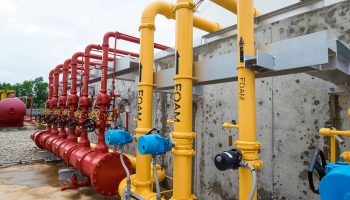Pre-Engineered Systems
Providing 24/7 Fire Protection To Your Business
A pre-engineered fire suppression system is a specialized fire protection system designed to rapidly and effectively suppress fires in specific areas or applications. It is a pre-designed system that integrates various components, such as detectors, control panels, agent storage containers, and distribution piping, into a cohesive unit. These systems are commonly used in commercial and industrial settings where fire hazards are present.
The primary purpose of a pre-engineered fire suppression system is to detect and extinguish fires at their early stages to minimize property damage, protect valuable assets, and ensure the safety of occupants. Unlike engineered systems that are custom-designed for a specific building, pre-engineered systems are manufactured and tested in accordance with recognized standards, making them a cost-effective solution for a wide range of applications.
Here is a breakdown of the key components and their functions within a typical pre-engineered fire suppression system:
- Detectors: These are devices that sense the presence of fire or smoke. Common types include heat detectors, smoke detectors, flame detectors, or a combination of these. When a detector is triggered, it sends a signal to the control panel.
- Control Panel: The control panel serves as the brain of the fire suppression system. It receives input from the detectors and activates the suppression system when a fire is detected. The panel also provides visual and audible alarms to alert occupants of the
potential danger. - Agent Storage Containers: The system employs various types of fire suppression agents, such as clean agents (e.g., FM-200, Novec 1230) or wet chemicals (e.g., wet chemical extinguishing agents for kitchen hood systems). These agents are stored in specially designed containers or cylinders, ready to be discharged in case of a fire.
- Distribution Piping: The agent distribution piping network carries the fire suppression agent from the storage containers to the protected areas. The piping is strategically installed to provide comprehensive coverage, ensuring that the agent can reach all parts of the protected area effectively.
- Nozzles/Discharge Outlets: These are positioned throughout the protected area to release the fire suppression agent. Nozzles and discharge outlets are carefully selected and positioned based on the specific hazard and desired coverage pattern.
When a fire is detected, the control panel initiates the release of the fire suppression agent through the distribution piping and out of the nozzles or discharge outlets. The agent displaces oxygen, cools the fire, interrupts the chemical chain reaction, or a combination of these actions, depending on the type of agent used. This effectively suppresses the fire and helps prevent its spread.
Pre-engineered fire suppression systems are subject to rigorous testing and certification to ensure their reliability and effectiveness. They are designed to meet industry standards and regulatory requirements, providing a reliable and efficient means of fire protection for a variety of applications, including server rooms, electrical equipment rooms, laboratories, paint booths, commercial kitchens, and more.
It is important to consult with a fire protection specialist or engineer to assess the specific fire hazards in your facility and determine the appropriate type of pre-engineered fire suppression system that meets your needs and complies with local regulations.

CO2 Systems

Foam Systems

Kitchen Hood Systems

Marine Systems

Halon, FE-13, FM-200

